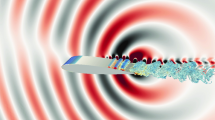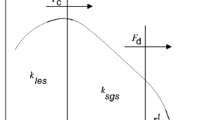Abstract
The paper describes an investigation into the predictive performance of linear and non-linear eddy-viscosity models and differential stress-transport closures for separated flow in a nominally two-dimensional, asymmetric diffuser. The test case forms part of a broader collaborative exercise between academic and industrial partners. It is demonstrated that advanced turbulence models using strain-dependent coefficients and anisotropy-resolving closure offer tangible advantages in predictive capability, although the quality of their performance can vary significantly, depending on the details of closure approximations adopted. Certain features of the flow defy resolution by any of the closures investigated. In particular, no model resolves correctly the flow near the diffuser's inclined wall immediately downstream of the inlet corner, which may reflect the presence of a “flapping” motion associated with a highly-localised process of unsteady separation and reattachment.
Similar content being viewed by others
References
Apsley, D.D. and Leschziner, M.A., A new low-Reynolds-number non-linear two-equation turbulence model for complex flows. Internat. J. Heat Fluid Flow 19 (1998) 209-222.
Baldwin, B.W. and Barth, T.A., One-equation turbulence transport model for high Reynolds number wall bounded flows. AIAA Paper 91-0610 (1991).
Batten, P., Craft, T.J., Leschziner, M.A. and Loyau, H., Reynolds stress transport modelling for compressible aerodynamic flows. AIAA J. 37 (1999) 785-796.
Buice, C.U. and Eaton, J.K., Experimental investigation of flow through an asymmetric plane diffuser. Report TSD-107, Department of Mechanical Engineering, Stanford University (1997).
Craft, T.J., Developments in a low-Reynolds-number second-moment closure and its application to separating and reattaching flows. Internat. J. Heat Fluid Flow 19 (1998) 541-548.
Craft, T.J. (ed.), Proceedings of the 7th ERCOFTAC/IAHR/COST Workshop on Refined Turbulence Modelling, 28–29 May. UMIST, Manchester (1998).
Craft, T.J., Launder, B.E. and Suga, K., Development and application of a cubic eddy-viscosity model of turbulence. Internat. J. Heat Fluid Flow 17 (1996) 108-115.
Craft, T.J., Launder, B.E. and Suga, K., Prediction of turbulent transitional phenomena with a nonlinear eddy-viscosity model. Internat. J. Heat Fluid Flow 18 (1997) 15-28.
Durbin, P.A., Separated flow computations with the k-ε-v 2 model. AIAA J. 33 (1995) 659-664.
Fatica, M., Kaltenbach, H.-J. and Mittal, R., Validation of large-eddy simulation in a plane asymmetric diffuser. In: Annual Research Briefs. Center for Turbulence Research, Stanford (1997) pp. 23-36.
Gatski, T.B. and Speziale, C.G., On explicit algebraic stress models for complex turbulent flows, J. Fluid Mech. 254 (1993) 59-78.
Gibson, M.M. and Launder, B.E., Ground effects on pressure fluctuations in the atmospheric boundary layer. J. Fluid Mech. 86 (1978) 491-511.
Hanjalić, K., Jakirlić, S. and Hadžić, I., Expanding the limits of “equilibrium” second-moment turbulence closures. Fluid Dynam. Res. 20 (1997) 25-41.
Hanjalic, K. and Launder, B.E., Sensitising the dissipation equation to irrotational strains. J. Fluids Engrg. 102 (1980) 34-40.
Hellsten, A. and Rautaheimo, P., (ed.), Proceedings of the 8th ERCOFTAC/IAHR/COST Workshop on Refined Turbulence Modelling, 17–18 June. Helsinki University of Technology (1999).
Jakirlić, S. and Hanjalić, K., A second-moment closure for non-equilibrium and separating high and low Re number flows. In: Durst, F., Launder, B.E., Schmidt, F. and Whitelaw, J.H. (eds), Proceedings 10th Symposium on Turbulent Shear Flows. Pennsylvania State University (1995) pp. 23.25-23.30.
Kalitzin, G., Gould, A.R.B. and Benton, J.J., Application of two-equation turbulence models in aircraft design. AIAA 96-0327 (1996).
Launder, B.E., Reece, G.J. and Rodi, W., Progress in the development of a Reynolds-stress turbulence closure. J. Fluid Mech. 68 (1975) 537-566.
Launder, B.E. and Sharma, B.I., Application of the energy-dissipation model of turbulence to the calculation of flow near a spinning disc. Lett. Heat Mass Transfer 1 (1974) 131-138.
Launder, B.E. and Spalding, D.B., The numerical computation of turbulent flows. Comput Meth. Appl. Mech. Engrg. 3 (1974) 269-28.
Leschziner, M.A. and Rodi, W., Calculation of annular and twin parallel jets using various discretisation schemes and turbulence-model variations. J. Fluids Engrg. 103 (1981) 352-360.
Lien, F.S. and Leschziner, M.A., A pressure-velocity solution strategy for compressible flow and its application to shock/boundary-layer interaction using second-moment turbulence closure, J. Fluids Engrg. 115 (1993) 717-725.
Menter, F.R., Two-equation eddy-viscosity turbulence models for engineering applications. AIAA J. 32 (1994) 1598-1605.
Obi, S., Aoki, K. and Masuda, S., Experimental and Computational study of turbulent separating flow in an asymmetric plane diffuser. In: Durst, F., Kasagi, N., Launder, B.E., Schmidt, F.W., Suzuki, K. and Whitelaw, J.H. (eds), Proceedings 9th Symposium on Turbulent Shear Flows, Kyoto, Japan, August 16–18. (1993) Paper P305-1.
Pope, S.B., 1975, A more general effective-viscosity hypothesis. J. Fluid Mech. 72 (1975) 331-340.
Reynolds, W.C. and Kassinos, S.C., One point modelling of rapidly deformed homogeneous turbulence, Proceedings Osborne Reynolds Centenary Symposium, Manchester. Proc. Roy. Soc. London, A 451 (1994) 87-104.
Spalart, P.R. and Almaras, S.R., A one-equation turbulence model for aerodynamic flows, AIAA Paper 92-0439 (1992).
Speziale, C.G., Sarkar, S. and Gatski, T.B., Modelling the pressure-strain correlation of turbulence: An invariant dynamical systems approach, J. Fluid Mech. 227 (1991) 245-272.
Speziale, C.G. and Xu, X-H., Towards the development of second-order closure models for nonequilibrium turbulent flows. Internat. J. Heat Fluid Flow 17 (1996) 238-244.
Wilcox, D.C., Reassessment of the scale-determining equation for advanced turbulence models. AIAA J. 26 (1988) 1299-1310.
Wilcox, D.C., Multiscale model for turbulent flows. AIAA J. 26 (1988) 1311-1320.
Wilcox, D.C., Simulation of transition with a two-equation turbulence model. AIAA J. 32 (1994) 247-255.
Author information
Authors and Affiliations
Rights and permissions
About this article
Cite this article
Apsley, D., Leschziner, M. Advanced Turbulence Modelling of Separated Flow in a Diffuser. Flow, Turbulence and Combustion 63, 81–112 (2000). https://doi.org/10.1023/A:1009930107544
Issue Date:
DOI: https://doi.org/10.1023/A:1009930107544




